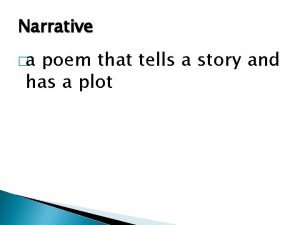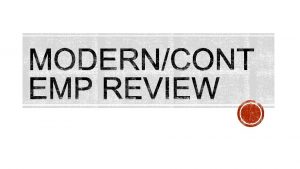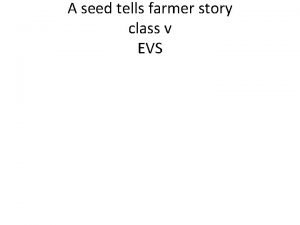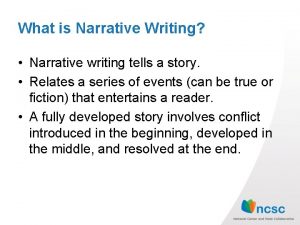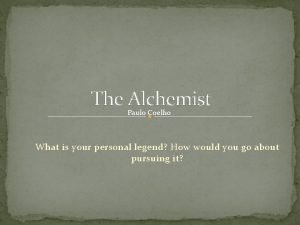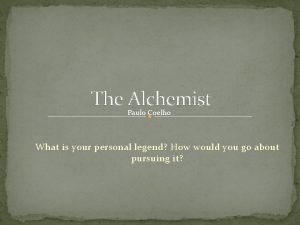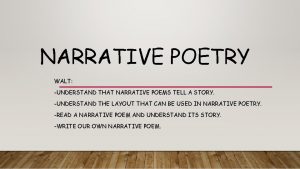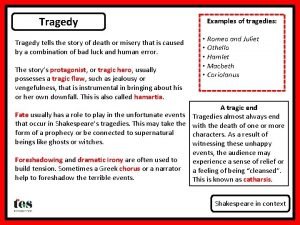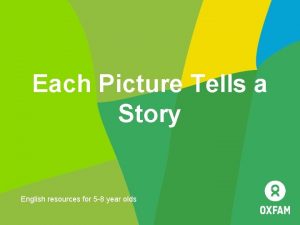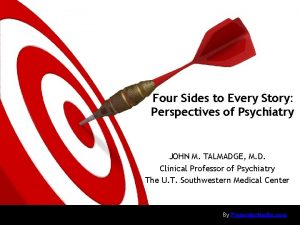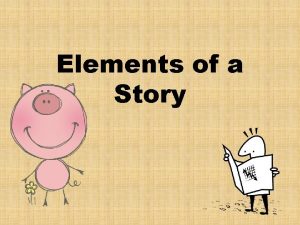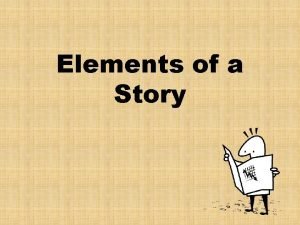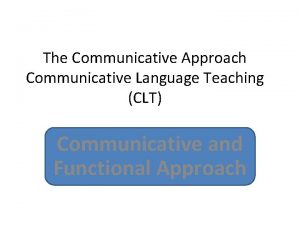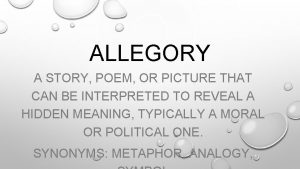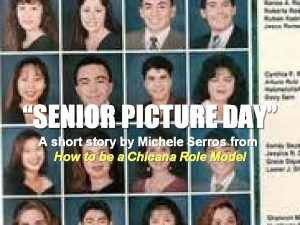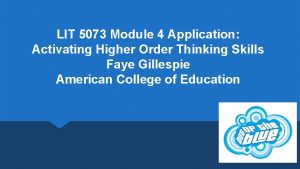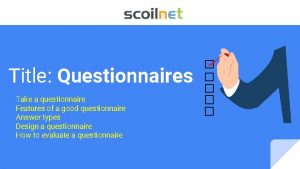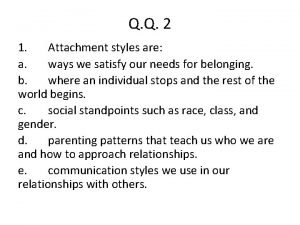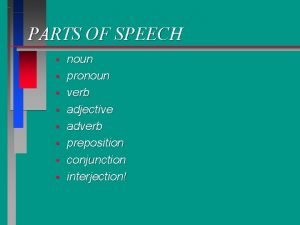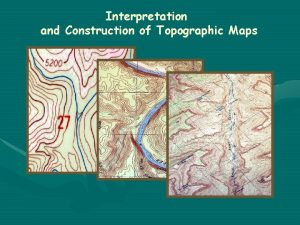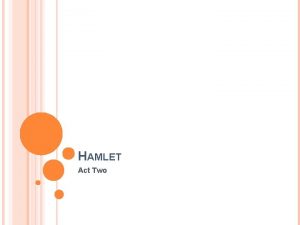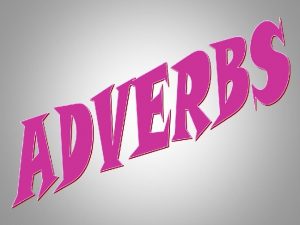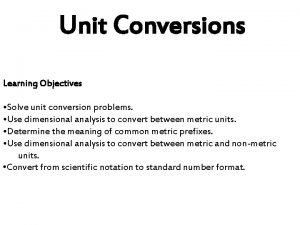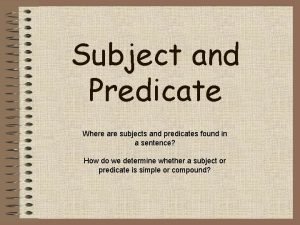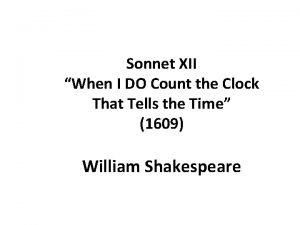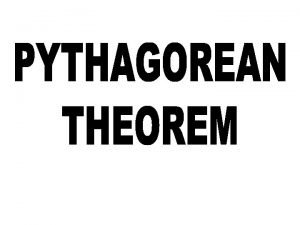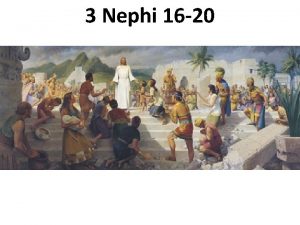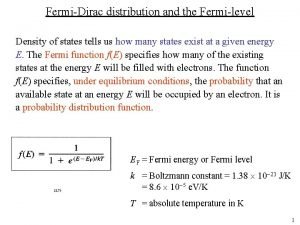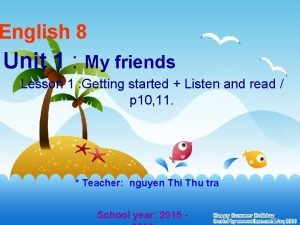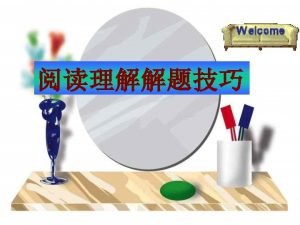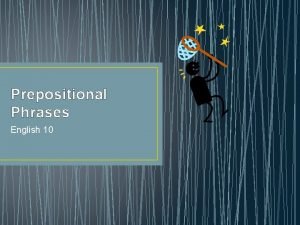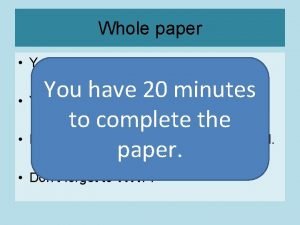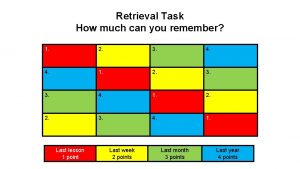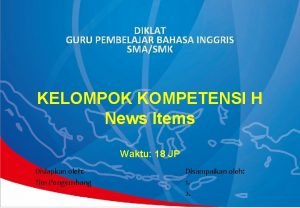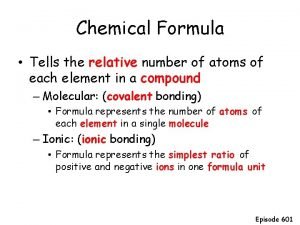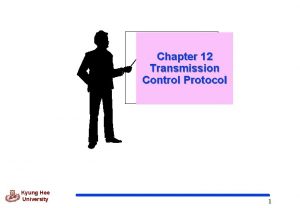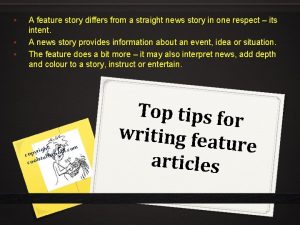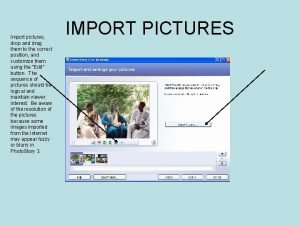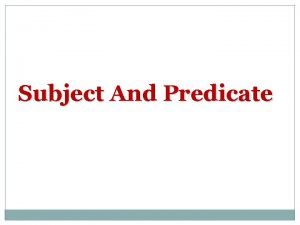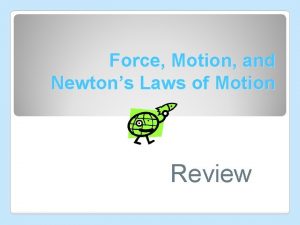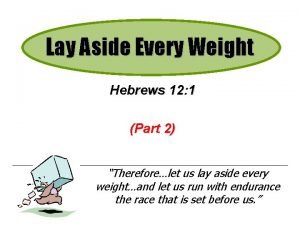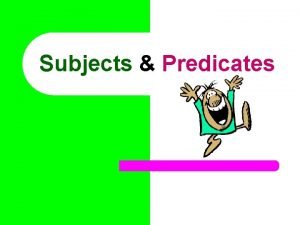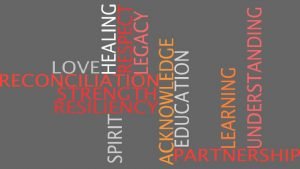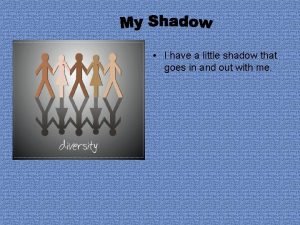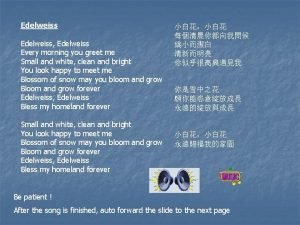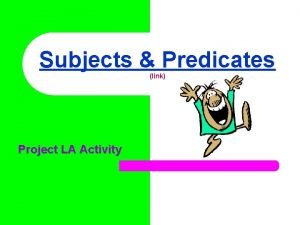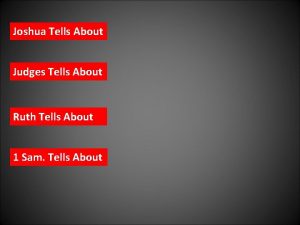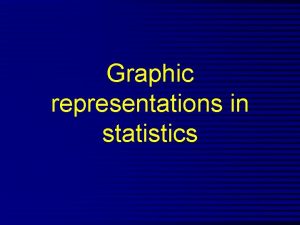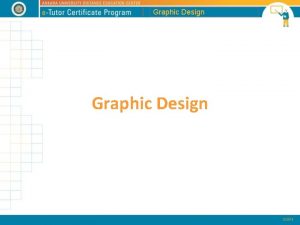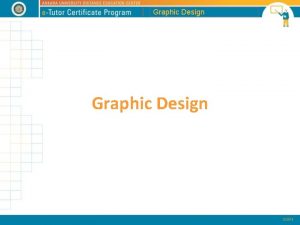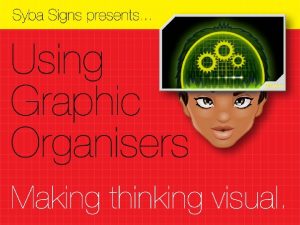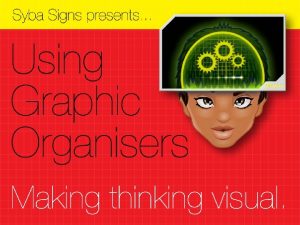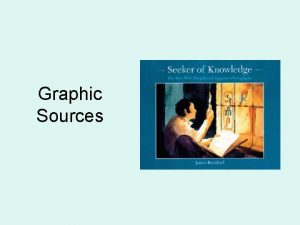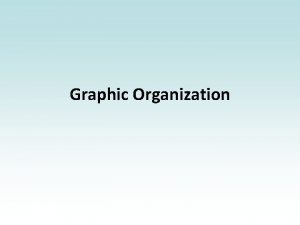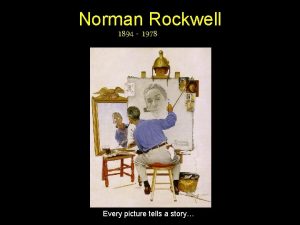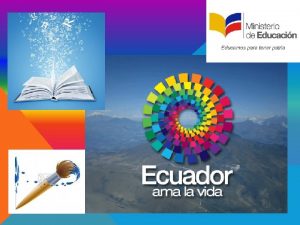Every Picture Tells a Story Graphic Depictions and

































































































- Slides: 97

Every Picture Tells a Story —Graphic Depictions and Planning and Evaluation By: Thomas J. Chapel, MA, MBA Office of the Director Office of Workforce and Career Development Centers for Disease Control and Prevention Tchapel@cdc. gov 404 -498 -6073

Today… n Be able to define and decribe how to use key graphic techniques/approaches: ¨ Logic models ¨ Logical framework (Logframes) ¨ Process maps/CPM ¨ Flow charts n Be able to construct high-level versions of each for simple cases 2

Every Picture Tells a Story Defining Terms

Defining Evaluation n Evaluation is the systematic investigation of the merit, worth, or significance of any “object” Michael Scriven n Program is any organized public health action/activity implemented to achieve some result 4

These must be integrated… n What do we do? Continuous Quality Improvement (CQI) cycle. ¨ Planning—What actions will best reach our goals and objectives. ¨ Performance measurement— How are we doing? ¨ Evaluation—Why are we doing well or poorly? How do we do it? How are we doing? 5

Framework for Program Evaluation Graphic technique choice lives here 6 6

Common Graphic Techniques Inputs Activities Outputs Process maps - Network diagrams What the charts - Flow program Decision What trees the program needs… GANNT charts does… Short-term Outcomes Intermediate Outcomes Long-term Outcomes/I mpacts Logic Models Logframes Strategy maps Concept maps Who/what will matrices change because Haddon of the program… Context, Assumptions 7

Every Picture Tells a Story Logic Models

Logic Models and Program Description n Logic Models : Graphic depictions of the relationship between your program’s activities and its intended effects 9

Typical Components of a Project/Program Inputs Activities What the program needs… Outputs What the program does… Short-term Outcomes Intermediate Outcomes Long-term Outcomes/I mpacts Who or what will change because of the program… Context and Assumptions External factors that influence getting to outcomes 10

What the program and its staff actually do Inputs Activities Outputs Short-term Effects/ Outcomes Intermediate Effects/ Outcomes Long-term Effects/ Outcomes/I mpacts Context Assumptions 11

Results of activities: Who/what will change? Inputs Activities Outputs Short-term Effects/ Outcomes Intermediate Effects/ Outcomes Long-term Effects/ Outcomes/I mpacts Context Assumptions 12

Constructing Logic Models: Identify Activities and Outcomes by…. 1. 2. 3. Examining program descriptions, MISSIONS, VISIONS, PLANS, ETC and extracting these from the narrative, OR Reverse mapping—Starting with outcomes, ask “how to” in order to generate the activities which produce them, OR Forward mapping—Starting with activities, ask “so what” in order to generate the outcomes that are expected to result 13

Then…Do Some Sequencing… n Divide the activities into 2 or more columns based on their logical sequence. Which activities have to occur before other activities can occur? n Do same with the outcomes. Which outcomes have to occur before other outcomes can occur? 14

Example: Listing Activities and Outcomes for Lead Poisoning Activities n n n n Outreach Screening Case management Referral for medical tx Identification of kids with elevated lead (EBLL) Environmental assessment Referral for env clean-up Family training Effects/Outcomes n n n n Lead source identified Families adopt in-home techniques Providers treats EBLL kids Housing Authority eliminates lead source EBLL reduced Developmental “slide” stopped 15 Q of L improved

Global Logic Model: Childhood Lead Poisoning Program Later Activities Early Activities If we do… And we do… Outreach Case mgmt of EBLL kids Screening ID of elevated kids Early Outcomes Then…. Refer EBLL kids for medical treatment EBLL kids get medical treatment Train family in inhome techniques Family performs in-home techniques Later Outcomes And then… EBLL reduced Develop’l slide stopped Quality of life improves Assess environment of EBLL child Lead source identified Refer environment for clean-up Environment gets cleaned up/Lead source removed 16

Lead Poisoning: “Causal” Roadmap Activities Outreach ___________Outcomes_____________ Do Environment Assessment Screening Train Families ID kids with EBLL Refer for ID Source and Lead Source Refer for clean-up Removed Family performs in-home techniques Reducing EBLLs Improved Development and Intelligence Medical Management Medical Treatment Case More Productive and/or Quality Lives Management 17

Global Logic Model: Eastside HIV/AIDS Prevention Early Activities If we … Develop materials and messages Select and train youth as peer educators Later Activities And we… Early Outcomes Then…. Do formal classroom presentations Do small group classroom discussions Do youth-led community ed Do 1 -1 street ed Distribute educational material Conduct community campaign: -Buscards/billboards - Posters/brochures Educational materials are brought home and shared Later Outcomes And then… Changes in youth knowledge, attitudes and beliefs Reduced HIV risk behavior Reduced incidence of HIV 18

Eastside HIV/AIDS Prevention Program: “Causal” Roadmap—”Dosage” Do formal presentations Do youth-led discussions Develop materials and Do 1 -1 messages street ed Distribute Select and train youth as peer educators educational materials Material shared at home Parents Changes in discuss and knowledge, reinforce attitudes, messages and beliefs of target youth Decreased HIV risk behavior of target youth Decreased incidence of HIV and AIDS Do small group sessions Conduct community campaign: PSAs Billboards Buscards Posters Brochures 19

Eastside HIV/AIDS Prevention Program: “Causal” Roadmap—Social Ecology Do formal presentations Do youth-led discussions Develop materials and Do 1 -1 messages street ed Distribute Select and train youth as peer educators educational materials Material shared at home Parents Changes in discuss and knowledge, reinforce attitudes, messages and beliefs of target youth Decreased HIV risk behavior of target youth Decreased incidence of HIV and AIDS Do small group sessions Conduct community campaign: PSAs Billboards Buscards Posters Brochures Community Supportive environment and ”community” norms KAB changes 20

Inputs Activities Outputs Short-term Effects/ Outcomes Context Assumptions Intermediate Effects/ Outcomes Long-term Effects/ Outcomes Tangible products of activities 21

Lead Poisoning: “Traditional” Outputs Pool (#) of screened kids n Pool (#) of eligible kids n Referrals (#) to medical treatment providers n Pool (#) of assessed homes n Referrals (#) for clean-up n 22

Lead Poisoning: “Causal” Roadmap Activities Outreach ___________Outcomes_____________ Do Environment Assessment Screening Train Families ID kids with EBLL Refer for ID Source and Lead Source Refer for clean-up Removed Family performs in-home techniques Reducing EBLLs Improved Development and Intelligence Medical Management Medical Treatment Case More Productive and/or Quality Lives Management 23

Lead Poisoning: “Upgraded” Outputs Pool (#) of screened kids (meeting likely risk profile) n Pool (#) of eligible kids (with lead level >XXd/ul) n Referrals (#) to (qualified or willing) medical treatment providers n Pool (#) of assessed (“leaded”) homes n Referrals (#) for clean-up (to qualified or willing orgs) n 24

Eastside: Outputs 1. 2. 3. 4. # of peer educators who have completed training; # who meet demog of targeted at risk youth % of busses with pre-tested buscards; % of “right” routes with busses with buscards # of 1: 1 street encounters with kids meeting high risk profile; % of street encounters with an “intake” or profile completed # of materials distributed directly to parents; % of materials pre-tested for acceptability with parents 25

Resource “platform” for the program Inputs Activities Outputs Short-term Effects/ Outcomes Intermediate Effects/ Outcomes Long-term Effects/ Outcomes Context Assumptions 26

Lead Poisoning: Sample Inputs n Funds n Trained staff n Relationships with orgs for med tx and env cleanup n Legal authority to screen 27

Eastside: Inputs 1. 2. 3. 4. Approval from school board Approval from buscompany Prior (sufficient) info on community norms, demog, values Prior (sufficient) inventory of relevant and useful materials 28

Lead Poisoning: “Causal” Roadmap Inputs Activities Outreach Outcomes Do Environment Assessment Screening Funds Refer for clean-up Removed Family performs Train R’ships Authority Lead Source in-home techniques Families Staff Legal ID Source and Refer for Medical Treatment Case Improved Development and Intelligence Medical Management ID kids with EBLL Reducing EBLLs More Productive and/or Quality Lives Management 29

Inputs Activities Moderators: Contextual factors that. Short-term will facilitate or Intermediate Effects/ Outputs hinder getting our Outcomes outcomes Long-term Effects/ Outcomes Context Assumptions 30

Contextual Factors n Political n Economic n Social n Technological 31

Moderators—Lead Poisoning n Political—“Hazard” politics n Economic— Health insurance n Technological— Availability of hand-held technology 32

Lead Poisoning: Full “Causal” Roadmap Inputs Outreach Funds ___________Outcomes_____________ Activities Screening Staff Do Environment Assessment ID Source and Lead Source Refer for clean-up Removed Train Family performs Families in-home techniques Reducing EBLLs Improved Development and Intelligence R’ships Legal Authority Medical Management ID kids with EBLL Refer for Medical Treatment More Productive and/or Quality Lives Case Management Moderators “Hazard politics” Health insurance coverage Availability of new technology Other… 33

Lead Poisoning: “Causal” Roadmap and ___________Outcomes_____________ Moderators Activities Outreach Do Environment Assessment Screening Train Families ID kids with EBLL Refer for ID Source and Lead Source Refer for clean-up Removed Family performs in-home techniques Reducing EBLLs Improved Development and Intelligence Medical Management Medical Treatment “hazard politics” Case Management More Productive and/or Quality Lives insurance climate technology 34

Eastside: Moderators 1. Political: 1. 2. 3. 2. Economic: 1. 3. Parent-school board/school r’ship Health dept/school r’ship Testing mania Car/bus ridership Social Norms/values about risk behaviors and solutions 2. Literacy/language 1. 4. Technological/Other 1. Condom/clean needle access 35

Framework“Program for description” stage frames decisions about Program Evaluation evaluation focus 36 36

Utility Questions n Purpose: Toward what end is the evaluation being conducted? n User: Who wants the info and what are they interested in? n Use: How will they use the info? 37

Feasibility Questions: “Reality Checking” the Focus n Questions that pass the “utility” test may be infeasible to include because: ¨Stage of Development: How long has the program been in existence? ¨Program Intensity: How intense is the program? How much impact is reasonable to expect? ¨Resources: How much time, money, expertise are available? 38

(Some) Potential Purposes/ Uses n Show accountability n Test program implementation n “Continuous” program improvement n Increase the knowledge base n Other… 39

Lead Poisoning: “Causal” Roadmap Inputs Activities Outreach Outcomes Do Environment Assessment ID Source and Lead Source Refer for clean-up Screening Funds Family performs Train Families Staff R’ships Legal Authority in-home techniques Improved Development and Intelligence Refer for Medical Treatment Case Reduce EBLLs Medical Management ID kids with EBLL Removed More Productive and/or Quality Lives Management 40

(Some) Potential Purposes/ Uses n Show n Test accountability program implementation n “Continuous” program improvement n Increase the knowledge base n Other… 41

Lead Poisoning: “Causal” Roadmap Inputs Activities Outcomes ID Source and Outreach Do Environment Assessment Refer for clean-up Funds Staff Screening Train in-home techniques Families R’ships kids Authority Reducing EBLLs Improved Development and Intelligence Refer for Medical Treatment Case Removed Medical Management ID EBLL Legal Family performs Lead Source More Productive and/or Quality Lives Management 42

Evaluation Focus: Lead Poisoning 43

A Logic Model Would Be (Most) Helpful When: n n n Thinking through options for how to address a new problem Clarity on program “logic”/”theory Clarity on sequencing of outcomes Desire to bring stakeholders to consensus on program purpose and evaluation Frame decisions about evaluation focus Other? 44

Every Picture Tells a Story Process Mapping and Project Management

Process Mapping n Structural analysis of a process flow, by distinguishing how work is actually done from how it should be done. Depicts main activities, information flows, interconnections, and measures are depicted as a graphic representation, allowing an observer to 'walkthrough' the whole process and see it in its entirety. Source: Business Dictionary. com 46

What is a Project? B D A E F C 1. Comprised of activities (tasks), requiring unique planning, to create a unique product/service. 2. Important inter-relationships among the activities. 1 3. Limited, finite life span, or duration. 47

Project Network Diagrams: Activity Interrelationships Activity B Activity A Activity D Activity C Start-to-Finish Relationships: • Activity A must finish before Activity B or Activity C can start. • Both B and C must finish before D can start. • “Project” is not completed until all four activities finish. 48

Why Use This Approach? 1. 2. 3. 4. 5. Forces discussion of activity interdependencies. Reinforces focus on meeting project objectives. IDs activities that can be executed in parallel IDs missing activities Provides l Consistent framework for planning. l Logical basis for determining project duration. l Framework for compressing project duration. 49

Drawing the Project Network Diagram 1. Draw from left to right: Place from 2. 3. 4. 5. predecessor activity successor activity Include only “direct predecessors” for each activity (if A B and B C, then no need to show A C). Use single arrow for each relationship – do not split/ combine arrows. Crossing lines is okay (use an “overpass” sign to avoid confusion) No need to “time- scale” the network diagram. 50

Exercise: Social Marketing Plan This project involves the development and pilot demonstration of a plan for “social marketing” of a nutrition and exercise program for hard-to-reach youth in rural areas…The project will commence with ACTIVITY A (signing of the approval by the Executive Director) and ACTIVITY B (budget approval for the marketing plan). ACTIVITY C (the design of the promotion plan) can follow immediately after ACTIVITY A. When both ACTIVITY B and ACTIVITY C are complete, ACTIVITY D (the promotion survey) can be conducted. ACTIVITY E (the promotion plan conceptualization and brainstorming sessions) can commence after ACTIVITY C is complete. ACTIVITY F (contracting with a local agency) can start after ACTIVITY B and Activity E are complete. ACTIVITY G (the analysis of survey data) can commence after ACTIVITY D is complete. ACTIVITY H (the writing of the draft promotion plan) can commence after ACTIVITY E. ACTIVITY I (promotion materials development) can be accomplished after ACTIVITY G and ACTIVITY H are both complete. ACTIVITY J (marketing plan final draft and presentation to the advisory committee) can be undertaken after ACTIVITY F and ACTIVITY I are complete. ACTIVITY K (pilot testing of the promotion plan) can commence after Activity J is complete. 51

Solution – Project Network Diagram: Social Marketing Plan C E H A D START B G I J K F 52

Eastside HIV/AIDS Prevention Program: “Causal” Roadmap Do formal presentations Do youth-led discussions Develop materials and Do 1 -1 messages street ed Distribute Select and train youth as peer educators educational materials Material shared at home Parents Changes in discuss and knowledge, reinforce attitudes, messages and beliefs of target youth Decreased HIV risk behavior of target youth Decreased incidence of HIV and AIDS Do small group sessions Conduct community campaign: PSAs Billboards Buscards Posters Brochures Community Supportive environment and ”community” norms KAB changes 53

Project Network Diagram—Eastside Do formal classroom presentations and small groups Develop final ID and ID strong test curricula messages and materials Distribute materials Develop final to take home materials Develop community and street outreach Conduct materials community ed ID and recruit Train peer educators END Conduct street outreach Develop posters, brochures, billboards, and buscards Display brochures and posters Engage community sites Display billboards Engage outdoor ad firm and buscards 54

Determining Critical Path § Critical Path: The connected series of activities whose combined duration represents the longest path through the network. § Why It Matters: § Determines the project duration. § If critical path activity is delayed, project is delayed. § To reduce project duration, must reduce time along critical path. § CP activities are leverage points 55

Critical Path—Key Definitions ES: Estimated Start D: Duration EF: Estimated Finish ES+D=EF ES D EF Activity LS TS LF LS: Latest Allowable Start TS: Total Slack (Float) LF: Latest Allowable Finish 42 56

Project Durations and Critical Path ES D EF Activity LS TS LF 6 7 13 B 0 0 6 0 4 13 6 2 15 D A 0 0 6 4 10 13 6 0 15 C 9 3 13 • Critical path activities A B D. • CP = 15 days (6 + 7 + 2 = 15). • Activities B and C can be undertaken concurrently. 42 57

Critical Path Diagram—Eastside START 6 Do formal classroom presentations and 4 8 ID and ID strong test curricula 4 Develop final 5 Develop final Develop community 8 curricula messages and materials small groups Distribute materials to take home materials 9 and street outreach Conduct materials community ed ID and recruit 4 4 Train peer educators 6 Conduct END 7 street outreach Develop posters, brochures, 8 billboards, and buscards Display brochures 3 and posters Engage community sites 2 Engage outdoor ad firm 4 Display billboards and buscards 6 58

Critical Path Diagram—Eastside 6 Do formal 22 classroom presentations and 8 4 ID and ID strong test curricula 4 Develop final 5 Develop final Develop community 8 curricula messages and materials small groups to take home materials 9 and street outreach Conduct materials community ed ID and recruit 25 Distribute materials 4 4 Train peer educators 6 Conduct 7 35 END 36 street outreach Develop posters, brochures, 8 billboards, and buscards Display brochures 3 and posters Engage community sites 2 Engage outdoor ad firm 4 Display billboards and buscards 6 27 28 59

Critical Path Diagram—Eastside 6 Do formal 22 classroom presentations and 8 4 ID and ID strong test curricula 4 Develop final 5 Develop final Develop community 8 curricula messages and materials small groups to take home materials 9 and street outreach Conduct materials community ed ID and recruit 25 Distribute materials 4 4 Train peer educators 6 Conduct 7 35 END 36 street outreach Develop posters, brochures, 8 billboards, and buscards Display brochures 3 and posters Engage community sites 2 Engage outdoor ad firm 4 Display billboards and buscards 6 27 28 60

Critical Path Diagram—Eastside 6 Do formal 22 classroom presentations and 8 4 ID and ID strong test curricula 4 Develop final 5 Develop final Develop community 8 curricula messages and materials small groups to take home materials 9 and street outreach Conduct materials community ed ID and recruit 25 Distribute materials 4 4 Train peer educators 6 Conduct 7 35 END 36 street outreach Develop posters, brochures, 8 billboards, and buscards Display brochures 3 and posters Engage community sites 2 Engage outdoor ad firm 4 Display billboards and buscards 6 27 28 61

Critical Path Diagram—Eastside 6 Do formal 22 classroom presentations and 8 4 ID and ID strong test curricula 4 Develop final 5 Develop final Develop community 8 curricula messages and materials small groups to take home materials 9 and street outreach Conduct materials community ed ID and recruit 25 Distribute materials 4 4 Train peer educators 6 Conduct 7 35 END 36 street outreach Develop posters, brochures, 8 billboards, and buscards Display brochures 3 and posters Engage community sites 2 Engage outdoor ad firm 4 Display billboards and buscards 6 27 28 62

Critical Path Diagram—Eastside 6 Do formal 22 classroom presentations and 8 4 ID and ID strong test curricula 4 Develop final 5 Develop final Develop community 8 curricula messages and materials small groups to take home materials 9 and street outreach Conduct materials community ed ID and recruit 25 Distribute materials 4 4 Train peer educators 6 Conduct 7 35 END 36 street outreach Develop posters, brochures, 8 billboards, and buscards Display brochures 3 and posters Engage community sites 2 Engage outdoor ad firm 4 Display billboards and buscards 6 27 28 63

Network Diagrams/CPM Would Be (Most) Helpful When: n n n Multi-faceted program Much interaction/interdependence among program activities Resources are scarce and/or time is of the essence Need to think through how to understand, control, and modify program duration Other? 64

Every Picture Tells a Story Flow Charts

What is a Flow Chart? n A pictorial representation describing the steps of a process in detail including inputs and intended outputs, key decision points, and alternative actions for each branch of a decision point. 66

Flow Chart—Standard Symbols Ovals—start/end Boxes--activities Arrows—direction of process Diamonds— decision points Make sure all paths are “closed”—take you either back or forward to another step! Source: Iowa State University, Facilities and Management Planning 67

Source: http: //deming. eng. clemson. edu/pub/tutorials/qctools/flowm. htm 68

Lead Poisoning: “Causal” Roadmap Activities Outreach ___________Outcomes_____________ Do Environment Assessment Screening Train Families ID kids with EBLL Refer for ID Source and Lead Source Refer for clean-up Removed Family performs in-home techniques Reducing EBLLs Improved Development and Intelligence Medical Management Medical Treatment Case More Productive and/or Quality Lives Management 69

End N N Do outreach Administer Y screening Lead Poisoning: Template Y Do blood Test questionnaire Y Management Refer for Train Followup Test Medical Mgmt Families at 3 months End Y Case N N Train Families Go to environmental assessment 70

End N N Do outreach High Y Risk? Administer screening questionnaire Lead Poisoning: Flow Chart Do EBLL? Y blood Test Y Management EBLL > XX? Y Refer for Train Followup Test Medical Mgmt Families at 3 months End Case EBLL? N N Train Families Go to environmental assessment 71

Flow Charts Would Be (Most) Helpful When: Much interaction/interdependence among program activities n Sequencing matters n Lots of “decision nodes” n Need clarity on next steps for all instances of each decision n Other? n 72

Every Picture Tells a Story Logical Framework Matrices (Logframes)

What is the Logical Framework Approach (LFA)? n A structured and logical means for planning, implementing, monitoring and evaluating projects, programs and institutional workplans 74

Origins of LFA USAID in 1960 s n Addressing related issues: n ¨ Projects failed to make impacts ¨ Projects could not name intended impacts ¨ Busted budgets and timelines ¨ Monitoring and evaluation done in isolation from stakeholders and intended target audiences 75

Main Components: Logical Framework Matrix (Logframe) Impact: The intended result to which the institution or project aspires to contribute— specified as “goal” and “purpose(s)”. n Institution/ Project: The outputs that will be produced to contribute to the desired impact. Activities to produce tangible outputs, and the inputs to mount activities. n The Operating Environment: the many external factors which are needed for outputs to contribute to purposes and for purposes to contribute to goals n 76

Logframe “Hierarchy” GOAL PURPOSE logic: EXTERNALHorizontal FACTORS If-And-Then OUTPUTS EXTERNAL FACTORS ACTIVITIES EXTERNAL FACTORS INPUTS Vertical logic: If-Then 77

Goal and Purpose Goal: Ultimate objective to which project is trying to contribute in the long term n Purpose: (More) immediate effect or impact of the work of the institution/project ¨(Often) only one purpose in a logframe ¨Something that makes significant contribution to achieving goal n But, is (usually) outside of the immediate control of the institution n 78

Outputs n Products/services/capacities which the institution/project agrees to deliver ¨Feasible for project to deliver ¨Should include all outputs needed to reach the purpose ¨For international projects often found in in the “terms of reference” 79

Activities and Inputs Activities: Group of actions related to producing each output ¨Activities necessary to produce the output n Only activities the institution/project will do n Inputs: People, funds, materials, services needed for activities to happen n 80

External Environment— Assumptions and Risks Assumptions—things which must exist for the project to succeed n Risks—things which, if missing, jeopardize success of project n Vertical logic: If And Then ¨ “Killer assumptions”—project redesign required n 81

Typical Logframe 82

Typical Components of a Project/Program Inputs Activities What the program needs… Outputs What the program does… Short-term Outcomes Intermediate Outcomes Long-term Outcomes/I mpacts Who/what will change because of the program… Moderators (Context, Assumptions) External factors that influence getting to outcomes 83

Typical Components. Pof a urpose(s ) A O ctivities a ut put s Project/Program nd G oal I nput s Inputs What the program needs… Activities Outputs Short-term Outcomes Intermediate Outcomes Long-term Outcomes/I mpacts Risks/ What the program Assumptions Who/what will change because does… of the program… Moderators (Context, Assumptions) External factors that influence getting to outcomes 84

Lead Poisoning: Full “Causal” Roadmap Inputs Outreach Funds ___________Outcomes_____________ Activities Screening Staff Do Environment Assessment ID Source and Lead Source Refer for clean-up Removed Train Family performs Families in-home techniques Reducing EBLLs Improved Development and Intelligence R’ships Legal Authority Medical Management ID kids with EBLL Refer for Medical Treatment More Productive and/or Quality Lives Case Management Moderators “Hazard politics” Health insurance coverage Availability of new technology Other… 85

Logframe—Lead Poisoning-1 86

Objectively Verifiable Indicators (OVIs) OVIs measure achievement of goal, purpose and outputs n Include ones that can be: ¨Verified at reasonable cost ¨Can be collected by project n 87

Logframe—Lead Poisoning-2 88

Eastside HIV/AIDS Prevention Program: “Causal” Roadmap Do formal presentations Do youth-led discussions Develop materials and Do 1 -1 messages street ed Distribute Select and train youth as peer educators educational materials Material shared at home Parents Changes in discuss and knowledge, reinforce attitudes, messages and beliefs of target youth Decreased HIV risk behavior of target youth Decreased incidence of HIV and AIDS Do small group sessions Conduct community campaign: PSAs Billboards Buscards Posters Brochures Community Supportive environment and ”community” norms KAB changes 89

Eastside Logframe n Using Eastside narrative and/or logic model, identify: ¨Goal ¨Purpose ¨Outputs ¨Activities ¨Inputs n ID some key assumptions and risks 90

Logframes vs. Logic Models Logframe pluses viz logic models: n Succinct n Integrates concept—measure— measurement from start n Forces link between external environment and project n Others? 91

Logframes vs. Logic Models Logframe minuses viz logic models: n Less attention to clear program theory— can lead to garbage in-garbage out n (Often) focuses on single purpose n Not good at handling “chains” of outcomes n Use of “outputs” a little garbled n External factors often a “rubbish” bin and not used strategically n Others? 92

Every Picture Tells a Story Life Post-Session

Helpful Publications @ www. cdc. gov/eval 94 94

Helpful Resources n n n NEW! Intro to Program Evaluation for PH Programs—A Self-Study Guide: http: //www. cdc. gov/eval/whatsnew. htm Logic Model Web Sites ¨ Innovation Network: http: //www. innonet. org/ ¨ Harvard Family Research Project: http: //www. gse. harvard. edu/hfrp/ ¨ University of Wisconsin-Extension: http: //www. uwex. edu/ces/lmcourse/ ¨ CDC/DASH: http: //www. cdc. gov/healthyyouth/evaluation/resources. htm#4 ¨ CDC/STD: http: //www. cdc. gov/std/program/progeval/TOCPGprogeval. htm Texts—Evaluation and Logic Models ¨ Kellogg Foundation Logic Model Development Guide: www. wkkf. org ¨ W. K. Kellogg Foundation Evaluation Resources: http: //www. wkkf. org/programming/overview. aspx? CID=281 ¨ Rogers et al. Program Theory in Evaluation. New Directions Series: Jossey-Bass, Fall 2000 ¨ Chen, H. Theory-Driven Evaluations. Sage. 1990 95

Helpful Resources Process Mapping/Flow Charts n Madison, Dan: Process Mapping, Process Improvement, and Process Management, Paton Press, 2005 n Joiner Associates: Flowcharts: Plain & Simple: Learning & Application Guide (Paperback), Oriel Inc. 1995 n Damielo, Robert: The Basics of Process Mapping (Paperback), Productivity Press, 1996 Logframes n The Knowledge and Research (Ka. R) Programme on Disability and Healthcare Technologies: Constructing a Logical Framework, http: //www. kar-dht. org/logframe. html n International Fund for Ag Development (IFAD): Linking Project Design, Annual Planning, and M&E, http: //www. ifad. org/evaluation/guide/3/3. htm n Campell, Jock, Innovation Centre, University of Exeter: Logical Frameworks, http: //www. innovation. ex. ac. uk/imm/GCRMN%20 Logframe 96 %20 training. pdf

Community Tool Box http: //ctb. ku. edu 97 97
 Every picture has a story and every story has a moment
Every picture has a story and every story has a moment Ghost graphic story graphic and wayfinding
Ghost graphic story graphic and wayfinding Every country and every nation
Every country and every nation Mission of microsoft
Mission of microsoft Every nation and every country
Every nation and every country What the picture tells us about
What the picture tells us about Sinnec
Sinnec Every knee shall bow every tongue confess
Every knee shall bow every tongue confess Every rotarian every year
Every rotarian every year Every child every day
Every child every day Graphic weight meaning
Graphic weight meaning Kamilah aisha moon
Kamilah aisha moon Song like poem that tells a story
Song like poem that tells a story Narrative verse meaning
Narrative verse meaning An intricate dance that tells a story
An intricate dance that tells a story A song transmitted orally which tells a story is called
A song transmitted orally which tells a story is called What if it finishes ppt
What if it finishes ppt Narrative writing tells a story
Narrative writing tells a story Pantomime is without words.
Pantomime is without words. A seed tells a farmers story summary
A seed tells a farmers story summary Narrative writing tells a story
Narrative writing tells a story The old man tells santiago the story about the miner
The old man tells santiago the story about the miner Why does coelho open with the modified myth of narcissus?
Why does coelho open with the modified myth of narcissus? Narrative writing tells a story to
Narrative writing tells a story to Narrative poetry elements
Narrative poetry elements What is a tragedy story
What is a tragedy story The story tells about
The story tells about The story tells about
The story tells about Non narrative poem
Non narrative poem Picture 1 picture 2
Picture 1 picture 2 Look at each picture and read the story
Look at each picture and read the story Four sides to every story
Four sides to every story Every story needs
Every story needs Parts of the exposition
Parts of the exposition Commutative approach
Commutative approach Allegory picture
Allegory picture Senior picture day short story
Senior picture day short story Picture strip story in communicative language teaching
Picture strip story in communicative language teaching Story picture prompts
Story picture prompts Imagine and explore
Imagine and explore Poem about romeo and juliet
Poem about romeo and juliet The title tells us the questionnaire's
The title tells us the questionnaire's Romeo and juliet act 5 scene 3 summary
Romeo and juliet act 5 scene 3 summary You are a very smart girl tammy tells her daughter
You are a very smart girl tammy tells her daughter Noun pronoun adjective verb adverb
Noun pronoun adjective verb adverb Stated main idea and implied main idea
Stated main idea and implied main idea D4t:h4p::l5r:? a)p4n b)q5m c)p5n d)q4n
D4t:h4p::l5r:? a)p4n b)q5m c)p5n d)q4n On a planimetric map the tells you the number
On a planimetric map the tells you the number Ophelia tells her father in scene i that hamlet is behaving
Ophelia tells her father in scene i that hamlet is behaving Explaining how something works
Explaining how something works Adverb tells when
Adverb tells when Adverb tells us more about
Adverb tells us more about Michael tells sara he weighs 104 pounds
Michael tells sara he weighs 104 pounds Simple predicates
Simple predicates Standard error of statistics
Standard error of statistics When i do count the clock that tells time
When i do count the clock that tells time Ms. green tells you that a right triangle
Ms. green tells you that a right triangle Service recovery iceberg tells us
Service recovery iceberg tells us 3 nephi 16
3 nephi 16 What is the name of the island tamal tells andy about
What is the name of the island tamal tells andy about Josef a high school student tells his therapist
Josef a high school student tells his therapist Fermi dirac distribution at t=0
Fermi dirac distribution at t=0 Which sentence tells you that hoa is older than nien
Which sentence tells you that hoa is older than nien What does the writer tell about
What does the writer tell about A preposition tells
A preposition tells A long narrative poem *
A long narrative poem * Tells what the whole paper is about.
Tells what the whole paper is about. Check if you can remember what tim tells you
Check if you can remember what tim tells you The text tells about
The text tells about The text tells us about
The text tells us about Newsworthy event background event source
Newsworthy event background event source Which of the following tells you population density
Which of the following tells you population density An html file is a text file containing small markup tags.
An html file is a text file containing small markup tags. A chemical formula tells what
A chemical formula tells what The server program tells its tcp
The server program tells its tcp A graphic language and has its own alphabet and grammar
A graphic language and has its own alphabet and grammar Once upon a time nadine gordimer characters
Once upon a time nadine gordimer characters Components of narrative writing
Components of narrative writing Moral of the story definition
Moral of the story definition Straight news article
Straight news article Short story introduction
Short story introduction Drag and drop picture and signature at the correct position
Drag and drop picture and signature at the correct position Every complete sentence contains two parts, a subject and a
Every complete sentence contains two parts, a subject and a For every action there is an equal and opposite reaction
For every action there is an equal and opposite reaction Every nation has its own
Every nation has its own Every living plants and animals must have
Every living plants and animals must have Lay off every weight
Lay off every weight Simple predicet
Simple predicet Every complete sentence contains two parts, a subject and a
Every complete sentence contains two parts, a subject and a Every country has its own traditions and customs
Every country has its own traditions and customs Every child matters honouring and remembering
Every child matters honouring and remembering I rose and found the shining dew on every buttercup
I rose and found the shining dew on every buttercup Can you greet me every morning
Can you greet me every morning Softwares can_ -in designing and modeling in every field
Softwares can_ -in designing and modeling in every field What is a simple predicate
What is a simple predicate Egg drop newton's first law
Egg drop newton's first law Simple present tense exemplos
Simple present tense exemplos Newtons 3 rd law
Newtons 3 rd law






